IoT Enabled Medical Devices: Disease Recognition & Treatment Project
VerifiedAdded on 2023/03/31
|28
|8441
|134
Report
AI Summary
This report provides an overview of the Internet of Things (IoT) and its applications in healthcare, focusing on how smart devices can improve patient care and medical treatments. It discusses the general use of IoT in healthcare, including remote patient monitoring, real-time data analysis, and the potential for life-saving applications. The report also addresses challenges such as data security, privacy, and data overload. It outlines a research methodology for further investigation, including the research philosophy, approach, design, data collection process, sampling, and data analysis method. The expected outcomes and future work are also discussed, highlighting the potential for IoT to transform healthcare by reducing death rates, hospital visits, and improving overall patient well-being. The document emphasizes how platforms like Desklib can help students with similar assignments.
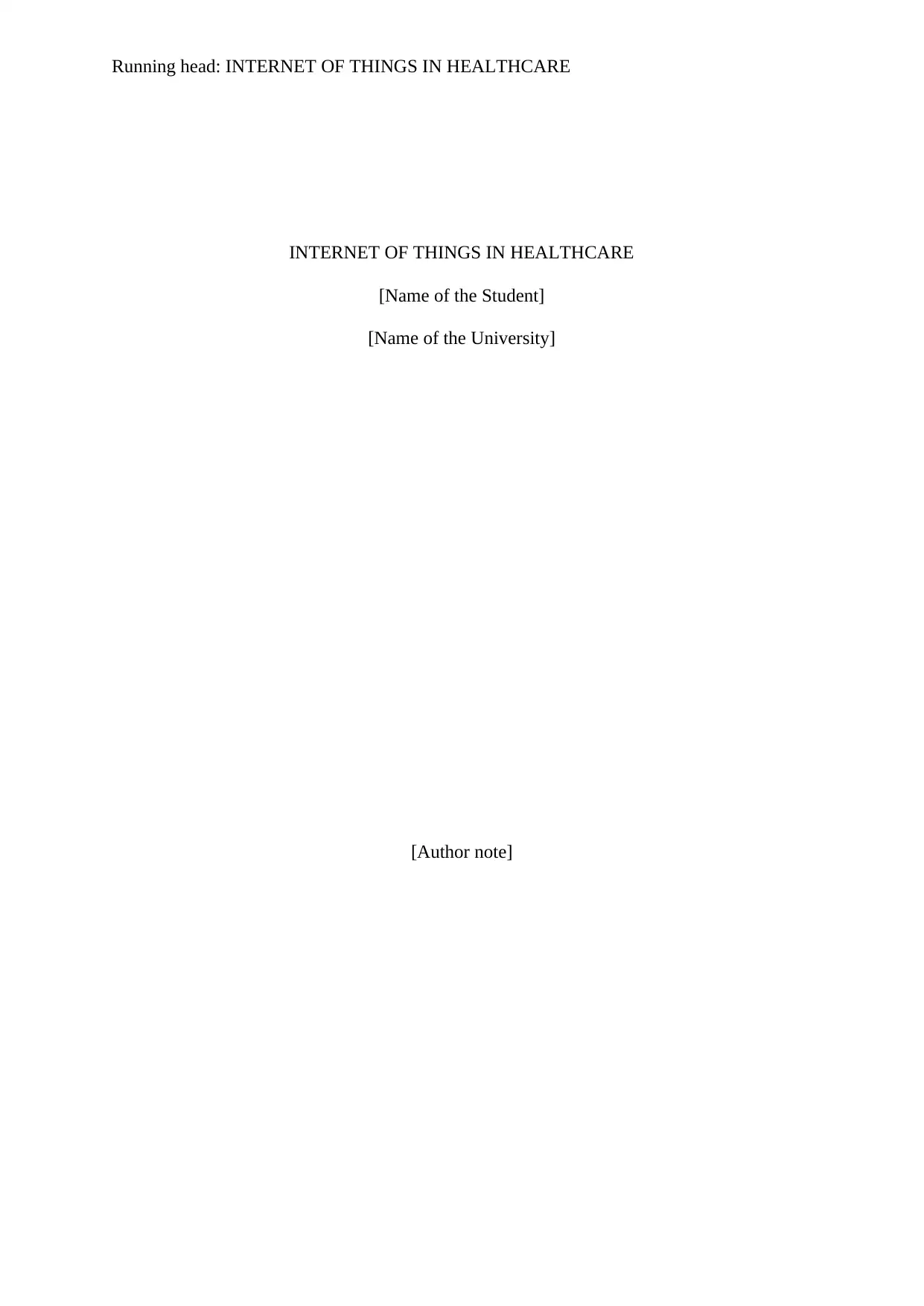
Running head: INTERNET OF THINGS IN HEALTHCARE
INTERNET OF THINGS IN HEALTHCARE
[Name of the Student]
[Name of the University]
[Author note]
INTERNET OF THINGS IN HEALTHCARE
[Name of the Student]
[Name of the University]
[Author note]
Paraphrase This Document
Need a fresh take? Get an instant paraphrase of this document with our AI Paraphraser
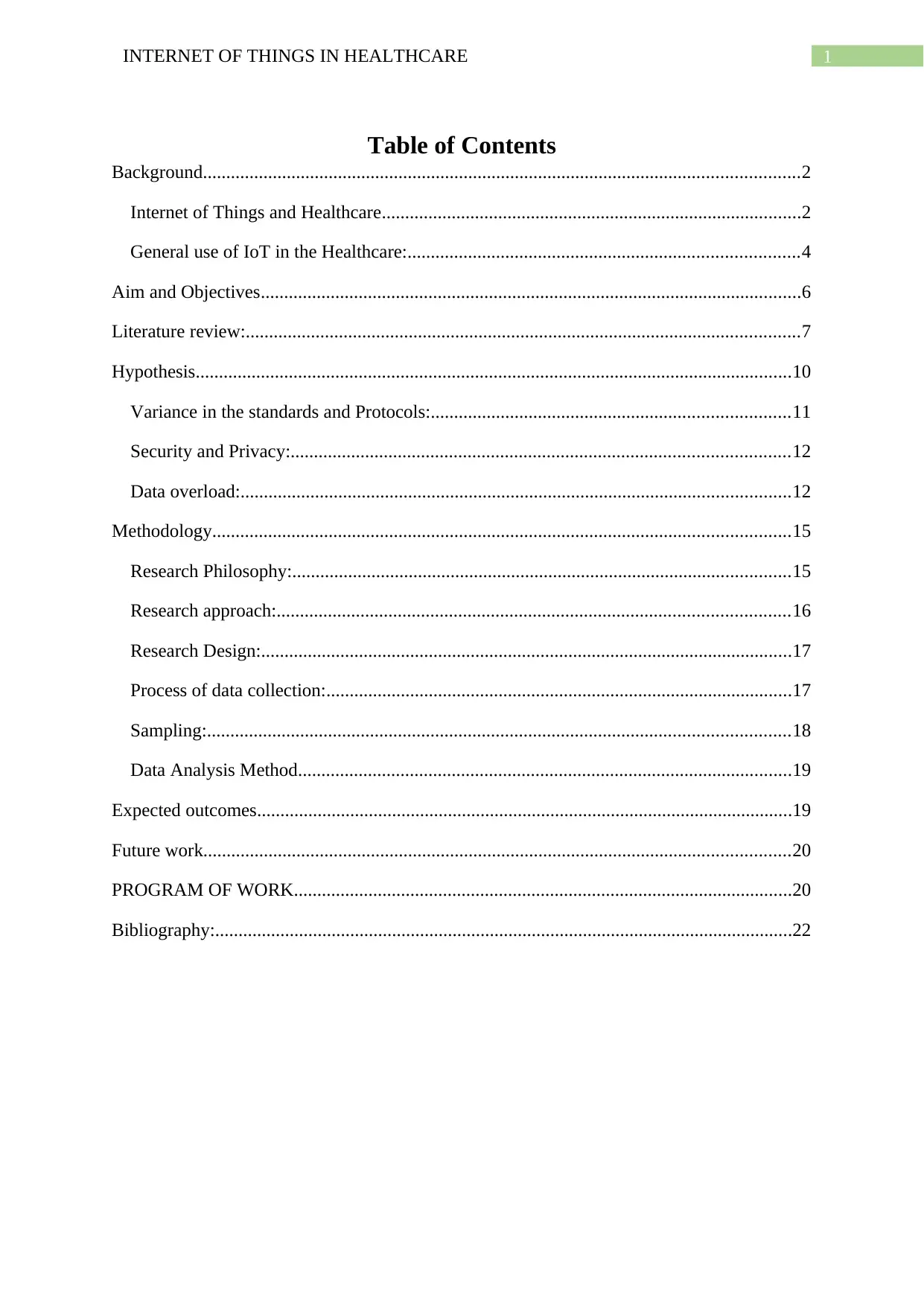
1INTERNET OF THINGS IN HEALTHCARE
Table of Contents
Background................................................................................................................................2
Internet of Things and Healthcare..........................................................................................2
General use of IoT in the Healthcare:....................................................................................4
Aim and Objectives....................................................................................................................6
Literature review:.......................................................................................................................7
Hypothesis................................................................................................................................10
Variance in the standards and Protocols:.............................................................................11
Security and Privacy:...........................................................................................................12
Data overload:......................................................................................................................12
Methodology............................................................................................................................15
Research Philosophy:...........................................................................................................15
Research approach:..............................................................................................................16
Research Design:..................................................................................................................17
Process of data collection:....................................................................................................17
Sampling:.............................................................................................................................18
Data Analysis Method..........................................................................................................19
Expected outcomes...................................................................................................................19
Future work..............................................................................................................................20
PROGRAM OF WORK...........................................................................................................20
Bibliography:............................................................................................................................22
Table of Contents
Background................................................................................................................................2
Internet of Things and Healthcare..........................................................................................2
General use of IoT in the Healthcare:....................................................................................4
Aim and Objectives....................................................................................................................6
Literature review:.......................................................................................................................7
Hypothesis................................................................................................................................10
Variance in the standards and Protocols:.............................................................................11
Security and Privacy:...........................................................................................................12
Data overload:......................................................................................................................12
Methodology............................................................................................................................15
Research Philosophy:...........................................................................................................15
Research approach:..............................................................................................................16
Research Design:..................................................................................................................17
Process of data collection:....................................................................................................17
Sampling:.............................................................................................................................18
Data Analysis Method..........................................................................................................19
Expected outcomes...................................................................................................................19
Future work..............................................................................................................................20
PROGRAM OF WORK...........................................................................................................20
Bibliography:............................................................................................................................22
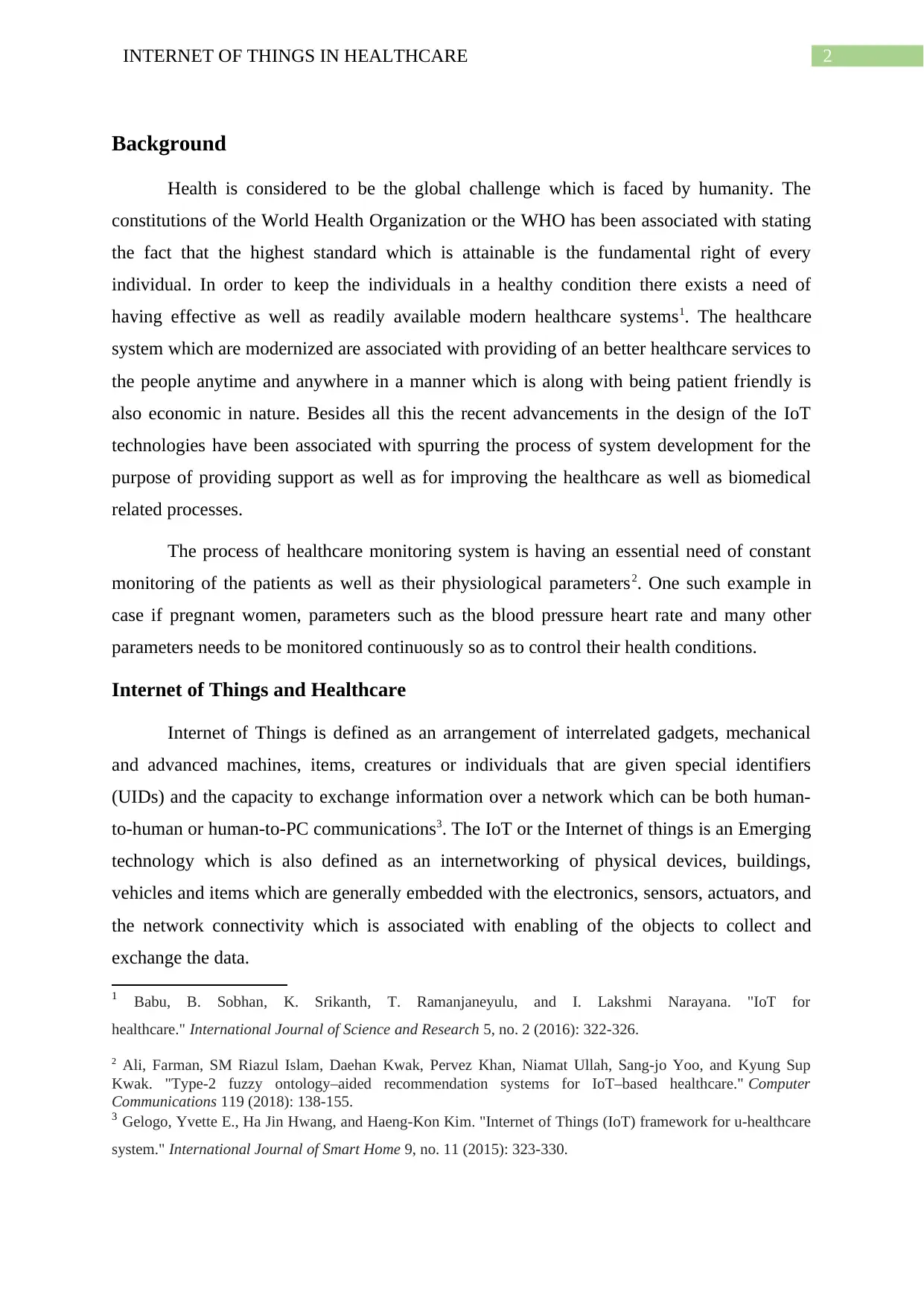
2INTERNET OF THINGS IN HEALTHCARE
Background
Health is considered to be the global challenge which is faced by humanity. The
constitutions of the World Health Organization or the WHO has been associated with stating
the fact that the highest standard which is attainable is the fundamental right of every
individual. In order to keep the individuals in a healthy condition there exists a need of
having effective as well as readily available modern healthcare systems1. The healthcare
system which are modernized are associated with providing of an better healthcare services to
the people anytime and anywhere in a manner which is along with being patient friendly is
also economic in nature. Besides all this the recent advancements in the design of the IoT
technologies have been associated with spurring the process of system development for the
purpose of providing support as well as for improving the healthcare as well as biomedical
related processes.
The process of healthcare monitoring system is having an essential need of constant
monitoring of the patients as well as their physiological parameters2. One such example in
case if pregnant women, parameters such as the blood pressure heart rate and many other
parameters needs to be monitored continuously so as to control their health conditions.
Internet of Things and Healthcare
Internet of Things is defined as an arrangement of interrelated gadgets, mechanical
and advanced machines, items, creatures or individuals that are given special identifiers
(UIDs) and the capacity to exchange information over a network which can be both human-
to-human or human-to-PC communications3. The IoT or the Internet of things is an Emerging
technology which is also defined as an internetworking of physical devices, buildings,
vehicles and items which are generally embedded with the electronics, sensors, actuators, and
the network connectivity which is associated with enabling of the objects to collect and
exchange the data.
1 Babu, B. Sobhan, K. Srikanth, T. Ramanjaneyulu, and I. Lakshmi Narayana. "IoT for
healthcare." International Journal of Science and Research 5, no. 2 (2016): 322-326.
2 Ali, Farman, SM Riazul Islam, Daehan Kwak, Pervez Khan, Niamat Ullah, Sang-jo Yoo, and Kyung Sup
Kwak. "Type-2 fuzzy ontology–aided recommendation systems for IoT–based healthcare." Computer
Communications 119 (2018): 138-155.
3 Gelogo, Yvette E., Ha Jin Hwang, and Haeng-Kon Kim. "Internet of Things (IoT) framework for u-healthcare
system." International Journal of Smart Home 9, no. 11 (2015): 323-330.
Background
Health is considered to be the global challenge which is faced by humanity. The
constitutions of the World Health Organization or the WHO has been associated with stating
the fact that the highest standard which is attainable is the fundamental right of every
individual. In order to keep the individuals in a healthy condition there exists a need of
having effective as well as readily available modern healthcare systems1. The healthcare
system which are modernized are associated with providing of an better healthcare services to
the people anytime and anywhere in a manner which is along with being patient friendly is
also economic in nature. Besides all this the recent advancements in the design of the IoT
technologies have been associated with spurring the process of system development for the
purpose of providing support as well as for improving the healthcare as well as biomedical
related processes.
The process of healthcare monitoring system is having an essential need of constant
monitoring of the patients as well as their physiological parameters2. One such example in
case if pregnant women, parameters such as the blood pressure heart rate and many other
parameters needs to be monitored continuously so as to control their health conditions.
Internet of Things and Healthcare
Internet of Things is defined as an arrangement of interrelated gadgets, mechanical
and advanced machines, items, creatures or individuals that are given special identifiers
(UIDs) and the capacity to exchange information over a network which can be both human-
to-human or human-to-PC communications3. The IoT or the Internet of things is an Emerging
technology which is also defined as an internetworking of physical devices, buildings,
vehicles and items which are generally embedded with the electronics, sensors, actuators, and
the network connectivity which is associated with enabling of the objects to collect and
exchange the data.
1 Babu, B. Sobhan, K. Srikanth, T. Ramanjaneyulu, and I. Lakshmi Narayana. "IoT for
healthcare." International Journal of Science and Research 5, no. 2 (2016): 322-326.
2 Ali, Farman, SM Riazul Islam, Daehan Kwak, Pervez Khan, Niamat Ullah, Sang-jo Yoo, and Kyung Sup
Kwak. "Type-2 fuzzy ontology–aided recommendation systems for IoT–based healthcare." Computer
Communications 119 (2018): 138-155.
3 Gelogo, Yvette E., Ha Jin Hwang, and Haeng-Kon Kim. "Internet of Things (IoT) framework for u-healthcare
system." International Journal of Smart Home 9, no. 11 (2015): 323-330.
⊘ This is a preview!⊘
Do you want full access?
Subscribe today to unlock all pages.

Trusted by 1+ million students worldwide
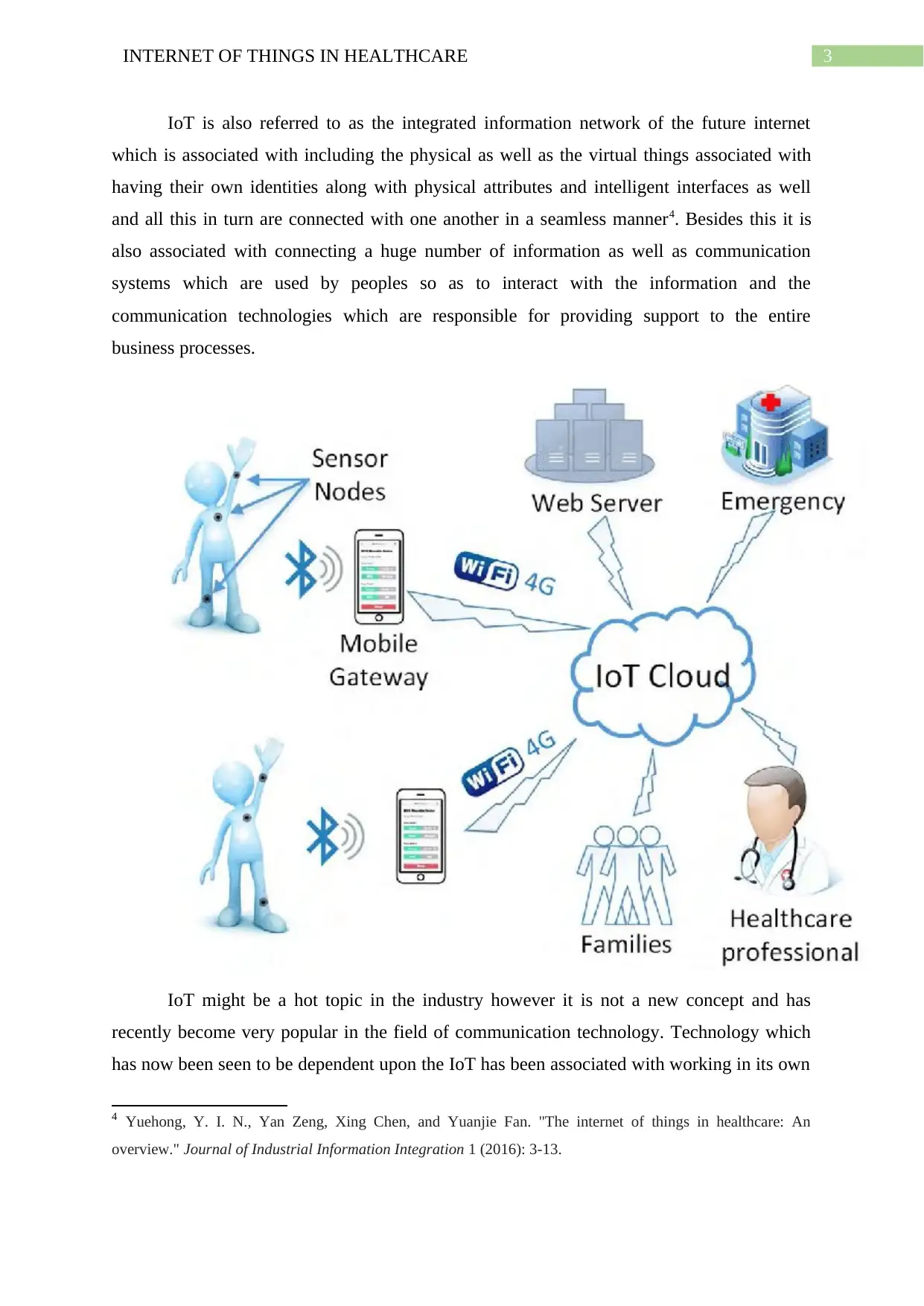
3INTERNET OF THINGS IN HEALTHCARE
IoT is also referred to as the integrated information network of the future internet
which is associated with including the physical as well as the virtual things associated with
having their own identities along with physical attributes and intelligent interfaces as well
and all this in turn are connected with one another in a seamless manner4. Besides this it is
also associated with connecting a huge number of information as well as communication
systems which are used by peoples so as to interact with the information and the
communication technologies which are responsible for providing support to the entire
business processes.
IoT might be a hot topic in the industry however it is not a new concept and has
recently become very popular in the field of communication technology. Technology which
has now been seen to be dependent upon the IoT has been associated with working in its own
4 Yuehong, Y. I. N., Yan Zeng, Xing Chen, and Yuanjie Fan. "The internet of things in healthcare: An
overview." Journal of Industrial Information Integration 1 (2016): 3-13.
IoT is also referred to as the integrated information network of the future internet
which is associated with including the physical as well as the virtual things associated with
having their own identities along with physical attributes and intelligent interfaces as well
and all this in turn are connected with one another in a seamless manner4. Besides this it is
also associated with connecting a huge number of information as well as communication
systems which are used by peoples so as to interact with the information and the
communication technologies which are responsible for providing support to the entire
business processes.
IoT might be a hot topic in the industry however it is not a new concept and has
recently become very popular in the field of communication technology. Technology which
has now been seen to be dependent upon the IoT has been associated with working in its own
4 Yuehong, Y. I. N., Yan Zeng, Xing Chen, and Yuanjie Fan. "The internet of things in healthcare: An
overview." Journal of Industrial Information Integration 1 (2016): 3-13.
Paraphrase This Document
Need a fresh take? Get an instant paraphrase of this document with our AI Paraphraser
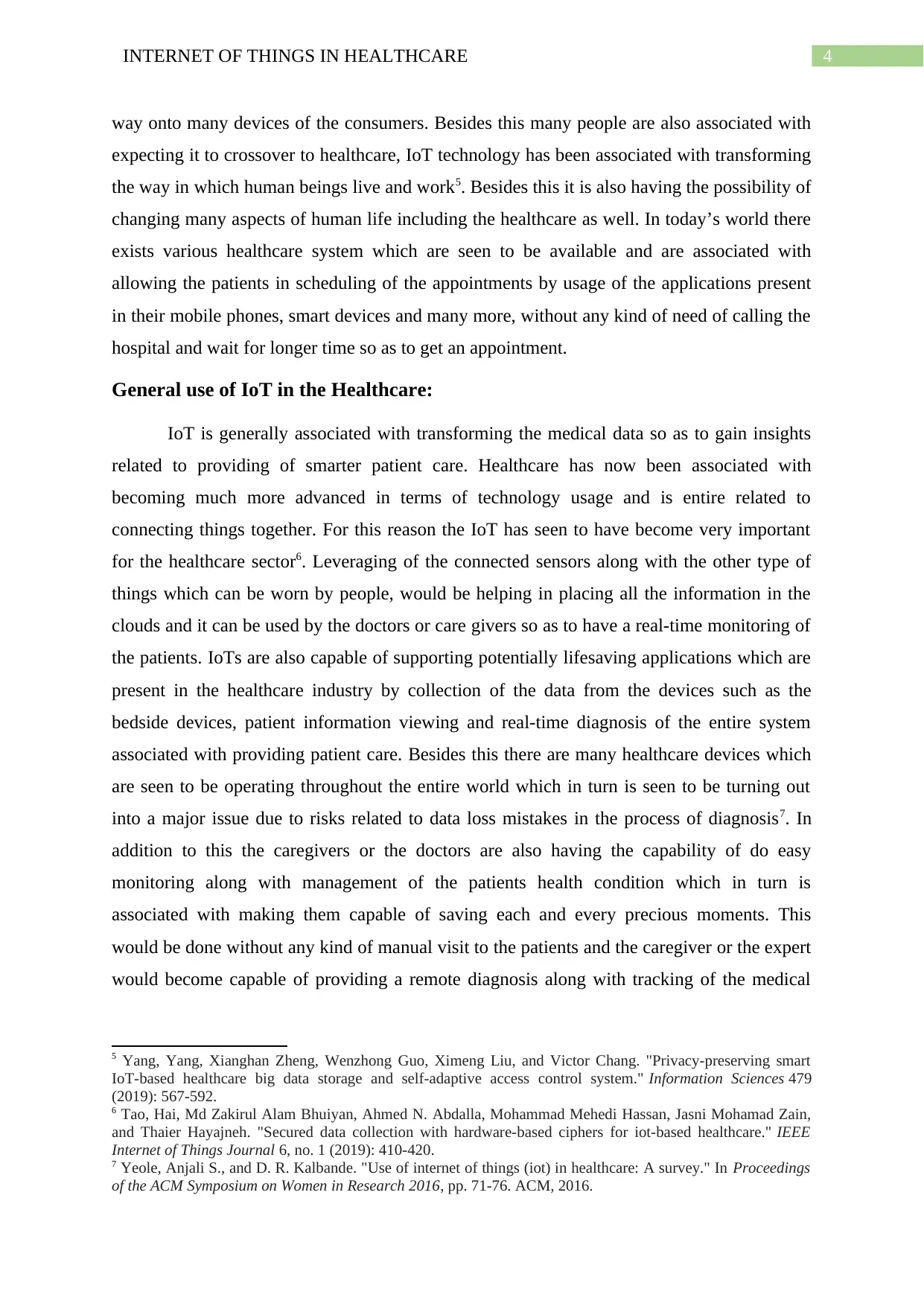
4INTERNET OF THINGS IN HEALTHCARE
way onto many devices of the consumers. Besides this many people are also associated with
expecting it to crossover to healthcare, IoT technology has been associated with transforming
the way in which human beings live and work5. Besides this it is also having the possibility of
changing many aspects of human life including the healthcare as well. In today’s world there
exists various healthcare system which are seen to be available and are associated with
allowing the patients in scheduling of the appointments by usage of the applications present
in their mobile phones, smart devices and many more, without any kind of need of calling the
hospital and wait for longer time so as to get an appointment.
General use of IoT in the Healthcare:
IoT is generally associated with transforming the medical data so as to gain insights
related to providing of smarter patient care. Healthcare has now been associated with
becoming much more advanced in terms of technology usage and is entire related to
connecting things together. For this reason the IoT has seen to have become very important
for the healthcare sector6. Leveraging of the connected sensors along with the other type of
things which can be worn by people, would be helping in placing all the information in the
clouds and it can be used by the doctors or care givers so as to have a real-time monitoring of
the patients. IoTs are also capable of supporting potentially lifesaving applications which are
present in the healthcare industry by collection of the data from the devices such as the
bedside devices, patient information viewing and real-time diagnosis of the entire system
associated with providing patient care. Besides this there are many healthcare devices which
are seen to be operating throughout the entire world which in turn is seen to be turning out
into a major issue due to risks related to data loss mistakes in the process of diagnosis7. In
addition to this the caregivers or the doctors are also having the capability of do easy
monitoring along with management of the patients health condition which in turn is
associated with making them capable of saving each and every precious moments. This
would be done without any kind of manual visit to the patients and the caregiver or the expert
would become capable of providing a remote diagnosis along with tracking of the medical
5 Yang, Yang, Xianghan Zheng, Wenzhong Guo, Ximeng Liu, and Victor Chang. "Privacy-preserving smart
IoT-based healthcare big data storage and self-adaptive access control system." Information Sciences 479
(2019): 567-592.
6 Tao, Hai, Md Zakirul Alam Bhuiyan, Ahmed N. Abdalla, Mohammad Mehedi Hassan, Jasni Mohamad Zain,
and Thaier Hayajneh. "Secured data collection with hardware-based ciphers for iot-based healthcare." IEEE
Internet of Things Journal 6, no. 1 (2019): 410-420.
7 Yeole, Anjali S., and D. R. Kalbande. "Use of internet of things (iot) in healthcare: A survey." In Proceedings
of the ACM Symposium on Women in Research 2016, pp. 71-76. ACM, 2016.
way onto many devices of the consumers. Besides this many people are also associated with
expecting it to crossover to healthcare, IoT technology has been associated with transforming
the way in which human beings live and work5. Besides this it is also having the possibility of
changing many aspects of human life including the healthcare as well. In today’s world there
exists various healthcare system which are seen to be available and are associated with
allowing the patients in scheduling of the appointments by usage of the applications present
in their mobile phones, smart devices and many more, without any kind of need of calling the
hospital and wait for longer time so as to get an appointment.
General use of IoT in the Healthcare:
IoT is generally associated with transforming the medical data so as to gain insights
related to providing of smarter patient care. Healthcare has now been associated with
becoming much more advanced in terms of technology usage and is entire related to
connecting things together. For this reason the IoT has seen to have become very important
for the healthcare sector6. Leveraging of the connected sensors along with the other type of
things which can be worn by people, would be helping in placing all the information in the
clouds and it can be used by the doctors or care givers so as to have a real-time monitoring of
the patients. IoTs are also capable of supporting potentially lifesaving applications which are
present in the healthcare industry by collection of the data from the devices such as the
bedside devices, patient information viewing and real-time diagnosis of the entire system
associated with providing patient care. Besides this there are many healthcare devices which
are seen to be operating throughout the entire world which in turn is seen to be turning out
into a major issue due to risks related to data loss mistakes in the process of diagnosis7. In
addition to this the caregivers or the doctors are also having the capability of do easy
monitoring along with management of the patients health condition which in turn is
associated with making them capable of saving each and every precious moments. This
would be done without any kind of manual visit to the patients and the caregiver or the expert
would become capable of providing a remote diagnosis along with tracking of the medical
5 Yang, Yang, Xianghan Zheng, Wenzhong Guo, Ximeng Liu, and Victor Chang. "Privacy-preserving smart
IoT-based healthcare big data storage and self-adaptive access control system." Information Sciences 479
(2019): 567-592.
6 Tao, Hai, Md Zakirul Alam Bhuiyan, Ahmed N. Abdalla, Mohammad Mehedi Hassan, Jasni Mohamad Zain,
and Thaier Hayajneh. "Secured data collection with hardware-based ciphers for iot-based healthcare." IEEE
Internet of Things Journal 6, no. 1 (2019): 410-420.
7 Yeole, Anjali S., and D. R. Kalbande. "Use of internet of things (iot) in healthcare: A survey." In Proceedings
of the ACM Symposium on Women in Research 2016, pp. 71-76. ACM, 2016.
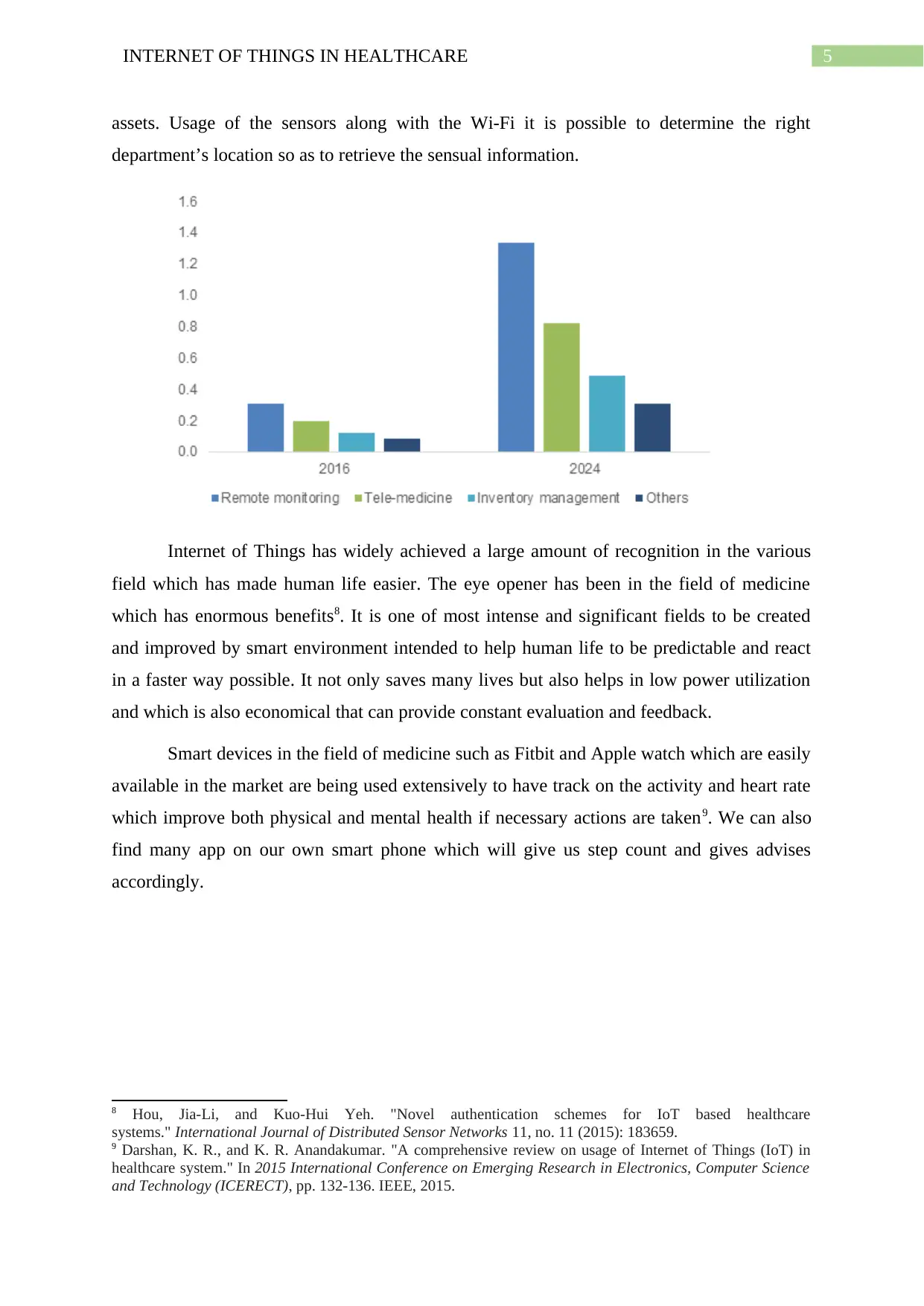
5INTERNET OF THINGS IN HEALTHCARE
assets. Usage of the sensors along with the Wi-Fi it is possible to determine the right
department’s location so as to retrieve the sensual information.
Internet of Things has widely achieved a large amount of recognition in the various
field which has made human life easier. The eye opener has been in the field of medicine
which has enormous benefits8. It is one of most intense and significant fields to be created
and improved by smart environment intended to help human life to be predictable and react
in a faster way possible. It not only saves many lives but also helps in low power utilization
and which is also economical that can provide constant evaluation and feedback.
Smart devices in the field of medicine such as Fitbit and Apple watch which are easily
available in the market are being used extensively to have track on the activity and heart rate
which improve both physical and mental health if necessary actions are taken9. We can also
find many app on our own smart phone which will give us step count and gives advises
accordingly.
8 Hou, Jia-Li, and Kuo-Hui Yeh. "Novel authentication schemes for IoT based healthcare
systems." International Journal of Distributed Sensor Networks 11, no. 11 (2015): 183659.
9 Darshan, K. R., and K. R. Anandakumar. "A comprehensive review on usage of Internet of Things (IoT) in
healthcare system." In 2015 International Conference on Emerging Research in Electronics, Computer Science
and Technology (ICERECT), pp. 132-136. IEEE, 2015.
assets. Usage of the sensors along with the Wi-Fi it is possible to determine the right
department’s location so as to retrieve the sensual information.
Internet of Things has widely achieved a large amount of recognition in the various
field which has made human life easier. The eye opener has been in the field of medicine
which has enormous benefits8. It is one of most intense and significant fields to be created
and improved by smart environment intended to help human life to be predictable and react
in a faster way possible. It not only saves many lives but also helps in low power utilization
and which is also economical that can provide constant evaluation and feedback.
Smart devices in the field of medicine such as Fitbit and Apple watch which are easily
available in the market are being used extensively to have track on the activity and heart rate
which improve both physical and mental health if necessary actions are taken9. We can also
find many app on our own smart phone which will give us step count and gives advises
accordingly.
8 Hou, Jia-Li, and Kuo-Hui Yeh. "Novel authentication schemes for IoT based healthcare
systems." International Journal of Distributed Sensor Networks 11, no. 11 (2015): 183659.
9 Darshan, K. R., and K. R. Anandakumar. "A comprehensive review on usage of Internet of Things (IoT) in
healthcare system." In 2015 International Conference on Emerging Research in Electronics, Computer Science
and Technology (ICERECT), pp. 132-136. IEEE, 2015.
⊘ This is a preview!⊘
Do you want full access?
Subscribe today to unlock all pages.

Trusted by 1+ million students worldwide
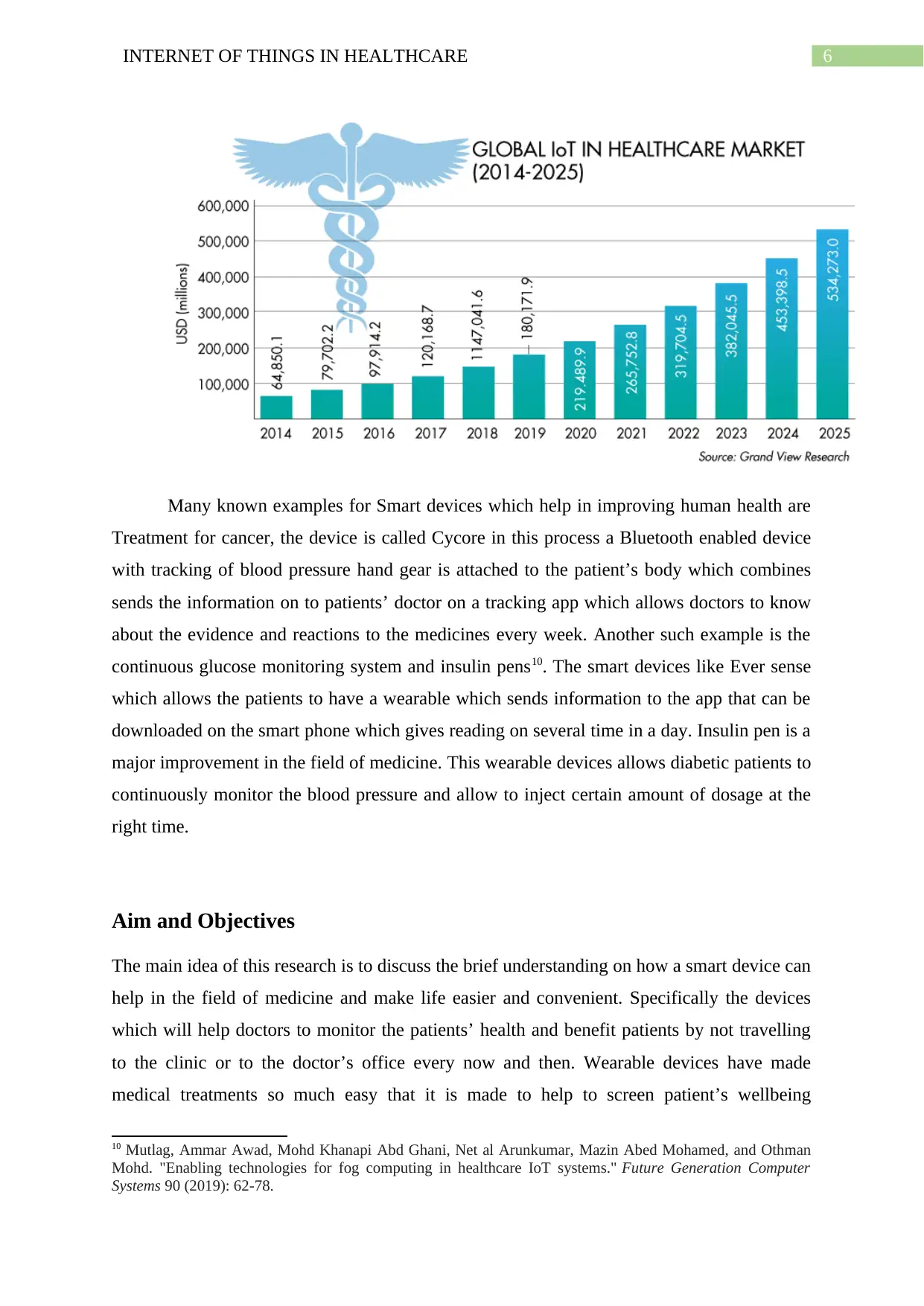
6INTERNET OF THINGS IN HEALTHCARE
Many known examples for Smart devices which help in improving human health are
Treatment for cancer, the device is called Cycore in this process a Bluetooth enabled device
with tracking of blood pressure hand gear is attached to the patient’s body which combines
sends the information on to patients’ doctor on a tracking app which allows doctors to know
about the evidence and reactions to the medicines every week. Another such example is the
continuous glucose monitoring system and insulin pens10. The smart devices like Ever sense
which allows the patients to have a wearable which sends information to the app that can be
downloaded on the smart phone which gives reading on several time in a day. Insulin pen is a
major improvement in the field of medicine. This wearable devices allows diabetic patients to
continuously monitor the blood pressure and allow to inject certain amount of dosage at the
right time.
Aim and Objectives
The main idea of this research is to discuss the brief understanding on how a smart device can
help in the field of medicine and make life easier and convenient. Specifically the devices
which will help doctors to monitor the patients’ health and benefit patients by not travelling
to the clinic or to the doctor’s office every now and then. Wearable devices have made
medical treatments so much easy that it is made to help to screen patient’s wellbeing
10 Mutlag, Ammar Awad, Mohd Khanapi Abd Ghani, Net al Arunkumar, Mazin Abed Mohamed, and Othman
Mohd. "Enabling technologies for fog computing in healthcare IoT systems." Future Generation Computer
Systems 90 (2019): 62-78.
Many known examples for Smart devices which help in improving human health are
Treatment for cancer, the device is called Cycore in this process a Bluetooth enabled device
with tracking of blood pressure hand gear is attached to the patient’s body which combines
sends the information on to patients’ doctor on a tracking app which allows doctors to know
about the evidence and reactions to the medicines every week. Another such example is the
continuous glucose monitoring system and insulin pens10. The smart devices like Ever sense
which allows the patients to have a wearable which sends information to the app that can be
downloaded on the smart phone which gives reading on several time in a day. Insulin pen is a
major improvement in the field of medicine. This wearable devices allows diabetic patients to
continuously monitor the blood pressure and allow to inject certain amount of dosage at the
right time.
Aim and Objectives
The main idea of this research is to discuss the brief understanding on how a smart device can
help in the field of medicine and make life easier and convenient. Specifically the devices
which will help doctors to monitor the patients’ health and benefit patients by not travelling
to the clinic or to the doctor’s office every now and then. Wearable devices have made
medical treatments so much easy that it is made to help to screen patient’s wellbeing
10 Mutlag, Ammar Awad, Mohd Khanapi Abd Ghani, Net al Arunkumar, Mazin Abed Mohamed, and Othman
Mohd. "Enabling technologies for fog computing in healthcare IoT systems." Future Generation Computer
Systems 90 (2019): 62-78.
Paraphrase This Document
Need a fresh take? Get an instant paraphrase of this document with our AI Paraphraser
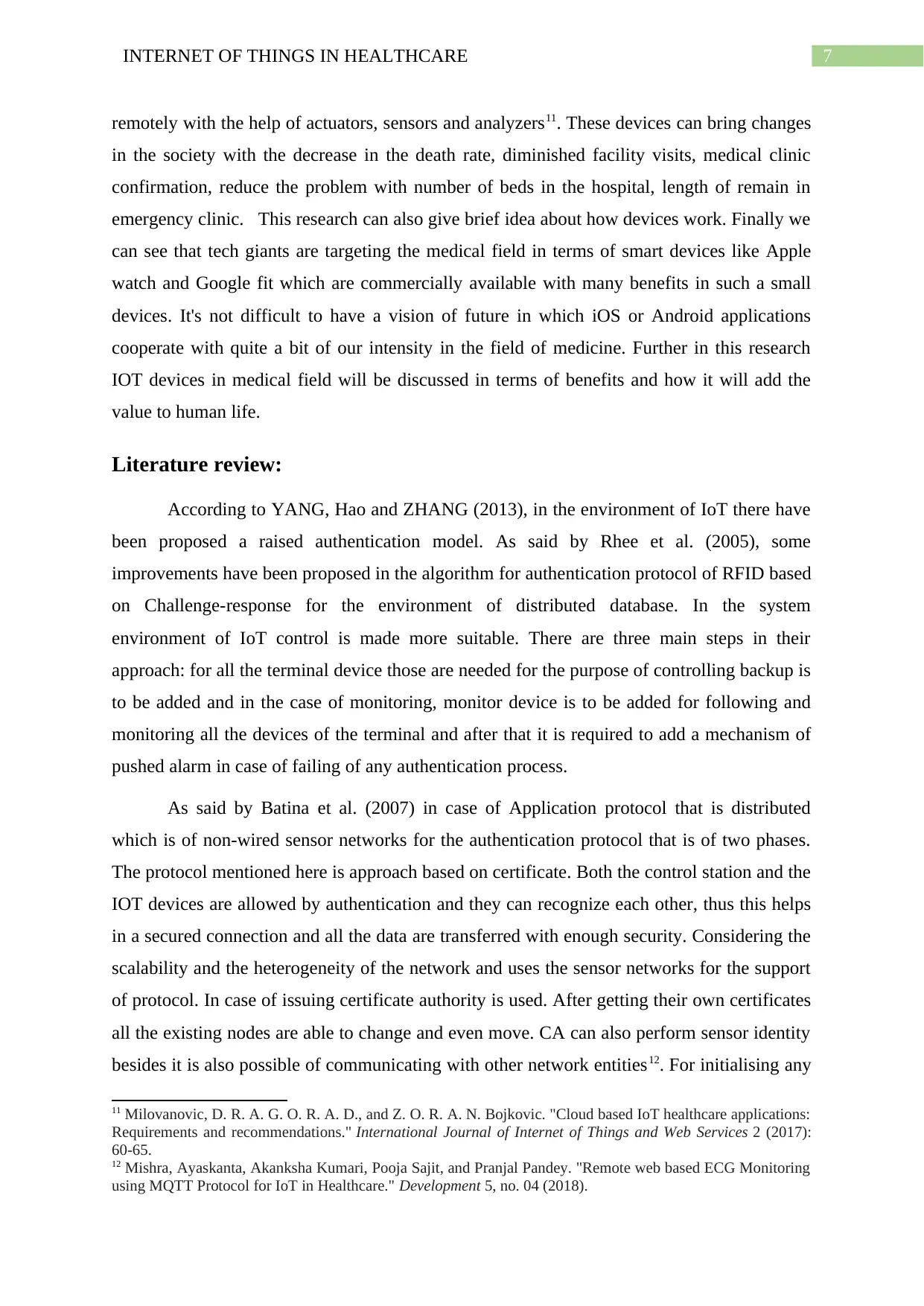
7INTERNET OF THINGS IN HEALTHCARE
remotely with the help of actuators, sensors and analyzers11. These devices can bring changes
in the society with the decrease in the death rate, diminished facility visits, medical clinic
confirmation, reduce the problem with number of beds in the hospital, length of remain in
emergency clinic. This research can also give brief idea about how devices work. Finally we
can see that tech giants are targeting the medical field in terms of smart devices like Apple
watch and Google fit which are commercially available with many benefits in such a small
devices. It's not difficult to have a vision of future in which iOS or Android applications
cooperate with quite a bit of our intensity in the field of medicine. Further in this research
IOT devices in medical field will be discussed in terms of benefits and how it will add the
value to human life.
Literature review:
According to YANG, Hao and ZHANG (2013), in the environment of IoT there have
been proposed a raised authentication model. As said by Rhee et al. (2005), some
improvements have been proposed in the algorithm for authentication protocol of RFID based
on Challenge-response for the environment of distributed database. In the system
environment of IoT control is made more suitable. There are three main steps in their
approach: for all the terminal device those are needed for the purpose of controlling backup is
to be added and in the case of monitoring, monitor device is to be added for following and
monitoring all the devices of the terminal and after that it is required to add a mechanism of
pushed alarm in case of failing of any authentication process.
As said by Batina et al. (2007) in case of Application protocol that is distributed
which is of non-wired sensor networks for the authentication protocol that is of two phases.
The protocol mentioned here is approach based on certificate. Both the control station and the
IOT devices are allowed by authentication and they can recognize each other, thus this helps
in a secured connection and all the data are transferred with enough security. Considering the
scalability and the heterogeneity of the network and uses the sensor networks for the support
of protocol. In case of issuing certificate authority is used. After getting their own certificates
all the existing nodes are able to change and even move. CA can also perform sensor identity
besides it is also possible of communicating with other network entities12. For initialising any
11 Milovanovic, D. R. A. G. O. R. A. D., and Z. O. R. A. N. Bojkovic. "Cloud based IoT healthcare applications:
Requirements and recommendations." International Journal of Internet of Things and Web Services 2 (2017):
60-65.
12 Mishra, Ayaskanta, Akanksha Kumari, Pooja Sajit, and Pranjal Pandey. "Remote web based ECG Monitoring
using MQTT Protocol for IoT in Healthcare." Development 5, no. 04 (2018).
remotely with the help of actuators, sensors and analyzers11. These devices can bring changes
in the society with the decrease in the death rate, diminished facility visits, medical clinic
confirmation, reduce the problem with number of beds in the hospital, length of remain in
emergency clinic. This research can also give brief idea about how devices work. Finally we
can see that tech giants are targeting the medical field in terms of smart devices like Apple
watch and Google fit which are commercially available with many benefits in such a small
devices. It's not difficult to have a vision of future in which iOS or Android applications
cooperate with quite a bit of our intensity in the field of medicine. Further in this research
IOT devices in medical field will be discussed in terms of benefits and how it will add the
value to human life.
Literature review:
According to YANG, Hao and ZHANG (2013), in the environment of IoT there have
been proposed a raised authentication model. As said by Rhee et al. (2005), some
improvements have been proposed in the algorithm for authentication protocol of RFID based
on Challenge-response for the environment of distributed database. In the system
environment of IoT control is made more suitable. There are three main steps in their
approach: for all the terminal device those are needed for the purpose of controlling backup is
to be added and in the case of monitoring, monitor device is to be added for following and
monitoring all the devices of the terminal and after that it is required to add a mechanism of
pushed alarm in case of failing of any authentication process.
As said by Batina et al. (2007) in case of Application protocol that is distributed
which is of non-wired sensor networks for the authentication protocol that is of two phases.
The protocol mentioned here is approach based on certificate. Both the control station and the
IOT devices are allowed by authentication and they can recognize each other, thus this helps
in a secured connection and all the data are transferred with enough security. Considering the
scalability and the heterogeneity of the network and uses the sensor networks for the support
of protocol. In case of issuing certificate authority is used. After getting their own certificates
all the existing nodes are able to change and even move. CA can also perform sensor identity
besides it is also possible of communicating with other network entities12. For initialising any
11 Milovanovic, D. R. A. G. O. R. A. D., and Z. O. R. A. N. Bojkovic. "Cloud based IoT healthcare applications:
Requirements and recommendations." International Journal of Internet of Things and Web Services 2 (2017):
60-65.
12 Mishra, Ayaskanta, Akanksha Kumari, Pooja Sajit, and Pranjal Pandey. "Remote web based ECG Monitoring
using MQTT Protocol for IoT in Healthcare." Development 5, no. 04 (2018).
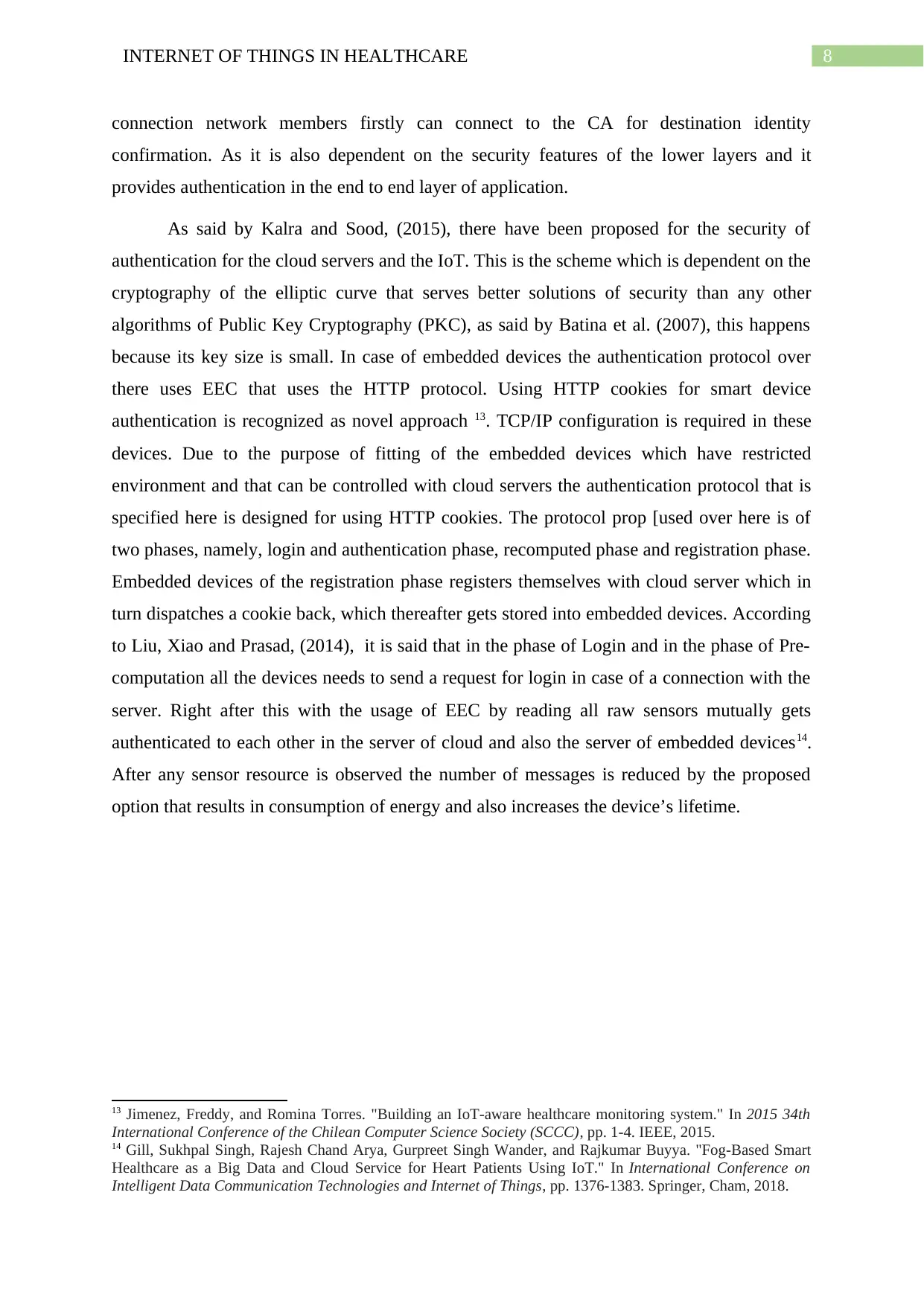
8INTERNET OF THINGS IN HEALTHCARE
connection network members firstly can connect to the CA for destination identity
confirmation. As it is also dependent on the security features of the lower layers and it
provides authentication in the end to end layer of application.
As said by Kalra and Sood, (2015), there have been proposed for the security of
authentication for the cloud servers and the IoT. This is the scheme which is dependent on the
cryptography of the elliptic curve that serves better solutions of security than any other
algorithms of Public Key Cryptography (PKC), as said by Batina et al. (2007), this happens
because its key size is small. In case of embedded devices the authentication protocol over
there uses EEC that uses the HTTP protocol. Using HTTP cookies for smart device
authentication is recognized as novel approach 13. TCP/IP configuration is required in these
devices. Due to the purpose of fitting of the embedded devices which have restricted
environment and that can be controlled with cloud servers the authentication protocol that is
specified here is designed for using HTTP cookies. The protocol prop [used over here is of
two phases, namely, login and authentication phase, recomputed phase and registration phase.
Embedded devices of the registration phase registers themselves with cloud server which in
turn dispatches a cookie back, which thereafter gets stored into embedded devices. According
to Liu, Xiao and Prasad, (2014), it is said that in the phase of Login and in the phase of Pre-
computation all the devices needs to send a request for login in case of a connection with the
server. Right after this with the usage of EEC by reading all raw sensors mutually gets
authenticated to each other in the server of cloud and also the server of embedded devices14.
After any sensor resource is observed the number of messages is reduced by the proposed
option that results in consumption of energy and also increases the device’s lifetime.
13 Jimenez, Freddy, and Romina Torres. "Building an IoT-aware healthcare monitoring system." In 2015 34th
International Conference of the Chilean Computer Science Society (SCCC), pp. 1-4. IEEE, 2015.
14 Gill, Sukhpal Singh, Rajesh Chand Arya, Gurpreet Singh Wander, and Rajkumar Buyya. "Fog-Based Smart
Healthcare as a Big Data and Cloud Service for Heart Patients Using IoT." In International Conference on
Intelligent Data Communication Technologies and Internet of Things, pp. 1376-1383. Springer, Cham, 2018.
connection network members firstly can connect to the CA for destination identity
confirmation. As it is also dependent on the security features of the lower layers and it
provides authentication in the end to end layer of application.
As said by Kalra and Sood, (2015), there have been proposed for the security of
authentication for the cloud servers and the IoT. This is the scheme which is dependent on the
cryptography of the elliptic curve that serves better solutions of security than any other
algorithms of Public Key Cryptography (PKC), as said by Batina et al. (2007), this happens
because its key size is small. In case of embedded devices the authentication protocol over
there uses EEC that uses the HTTP protocol. Using HTTP cookies for smart device
authentication is recognized as novel approach 13. TCP/IP configuration is required in these
devices. Due to the purpose of fitting of the embedded devices which have restricted
environment and that can be controlled with cloud servers the authentication protocol that is
specified here is designed for using HTTP cookies. The protocol prop [used over here is of
two phases, namely, login and authentication phase, recomputed phase and registration phase.
Embedded devices of the registration phase registers themselves with cloud server which in
turn dispatches a cookie back, which thereafter gets stored into embedded devices. According
to Liu, Xiao and Prasad, (2014), it is said that in the phase of Login and in the phase of Pre-
computation all the devices needs to send a request for login in case of a connection with the
server. Right after this with the usage of EEC by reading all raw sensors mutually gets
authenticated to each other in the server of cloud and also the server of embedded devices14.
After any sensor resource is observed the number of messages is reduced by the proposed
option that results in consumption of energy and also increases the device’s lifetime.
13 Jimenez, Freddy, and Romina Torres. "Building an IoT-aware healthcare monitoring system." In 2015 34th
International Conference of the Chilean Computer Science Society (SCCC), pp. 1-4. IEEE, 2015.
14 Gill, Sukhpal Singh, Rajesh Chand Arya, Gurpreet Singh Wander, and Rajkumar Buyya. "Fog-Based Smart
Healthcare as a Big Data and Cloud Service for Heart Patients Using IoT." In International Conference on
Intelligent Data Communication Technologies and Internet of Things, pp. 1376-1383. Springer, Cham, 2018.
⊘ This is a preview!⊘
Do you want full access?
Subscribe today to unlock all pages.

Trusted by 1+ million students worldwide
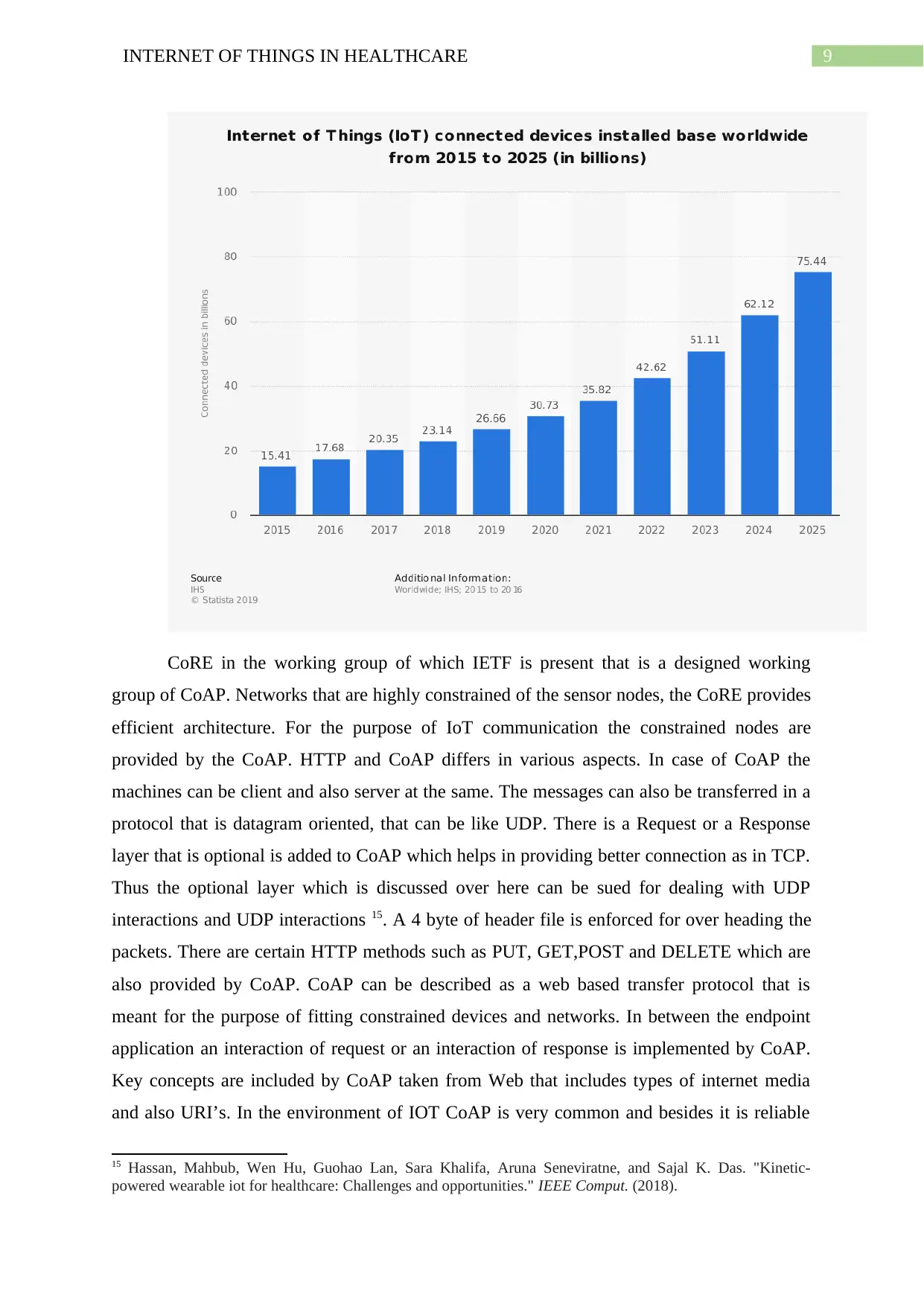
9INTERNET OF THINGS IN HEALTHCARE
CoRE in the working group of which IETF is present that is a designed working
group of CoAP. Networks that are highly constrained of the sensor nodes, the CoRE provides
efficient architecture. For the purpose of IoT communication the constrained nodes are
provided by the CoAP. HTTP and CoAP differs in various aspects. In case of CoAP the
machines can be client and also server at the same. The messages can also be transferred in a
protocol that is datagram oriented, that can be like UDP. There is a Request or a Response
layer that is optional is added to CoAP which helps in providing better connection as in TCP.
Thus the optional layer which is discussed over here can be sued for dealing with UDP
interactions and UDP interactions 15. A 4 byte of header file is enforced for over heading the
packets. There are certain HTTP methods such as PUT, GET,POST and DELETE which are
also provided by CoAP. CoAP can be described as a web based transfer protocol that is
meant for the purpose of fitting constrained devices and networks. In between the endpoint
application an interaction of request or an interaction of response is implemented by CoAP.
Key concepts are included by CoAP taken from Web that includes types of internet media
and also URI’s. In the environment of IOT CoAP is very common and besides it is reliable
15 Hassan, Mahbub, Wen Hu, Guohao Lan, Sara Khalifa, Aruna Seneviratne, and Sajal K. Das. "Kinetic-
powered wearable iot for healthcare: Challenges and opportunities." IEEE Comput. (2018).
CoRE in the working group of which IETF is present that is a designed working
group of CoAP. Networks that are highly constrained of the sensor nodes, the CoRE provides
efficient architecture. For the purpose of IoT communication the constrained nodes are
provided by the CoAP. HTTP and CoAP differs in various aspects. In case of CoAP the
machines can be client and also server at the same. The messages can also be transferred in a
protocol that is datagram oriented, that can be like UDP. There is a Request or a Response
layer that is optional is added to CoAP which helps in providing better connection as in TCP.
Thus the optional layer which is discussed over here can be sued for dealing with UDP
interactions and UDP interactions 15. A 4 byte of header file is enforced for over heading the
packets. There are certain HTTP methods such as PUT, GET,POST and DELETE which are
also provided by CoAP. CoAP can be described as a web based transfer protocol that is
meant for the purpose of fitting constrained devices and networks. In between the endpoint
application an interaction of request or an interaction of response is implemented by CoAP.
Key concepts are included by CoAP taken from Web that includes types of internet media
and also URI’s. In the environment of IOT CoAP is very common and besides it is reliable
15 Hassan, Mahbub, Wen Hu, Guohao Lan, Sara Khalifa, Aruna Seneviratne, and Sajal K. Das. "Kinetic-
powered wearable iot for healthcare: Challenges and opportunities." IEEE Comput. (2018).
Paraphrase This Document
Need a fresh take? Get an instant paraphrase of this document with our AI Paraphraser
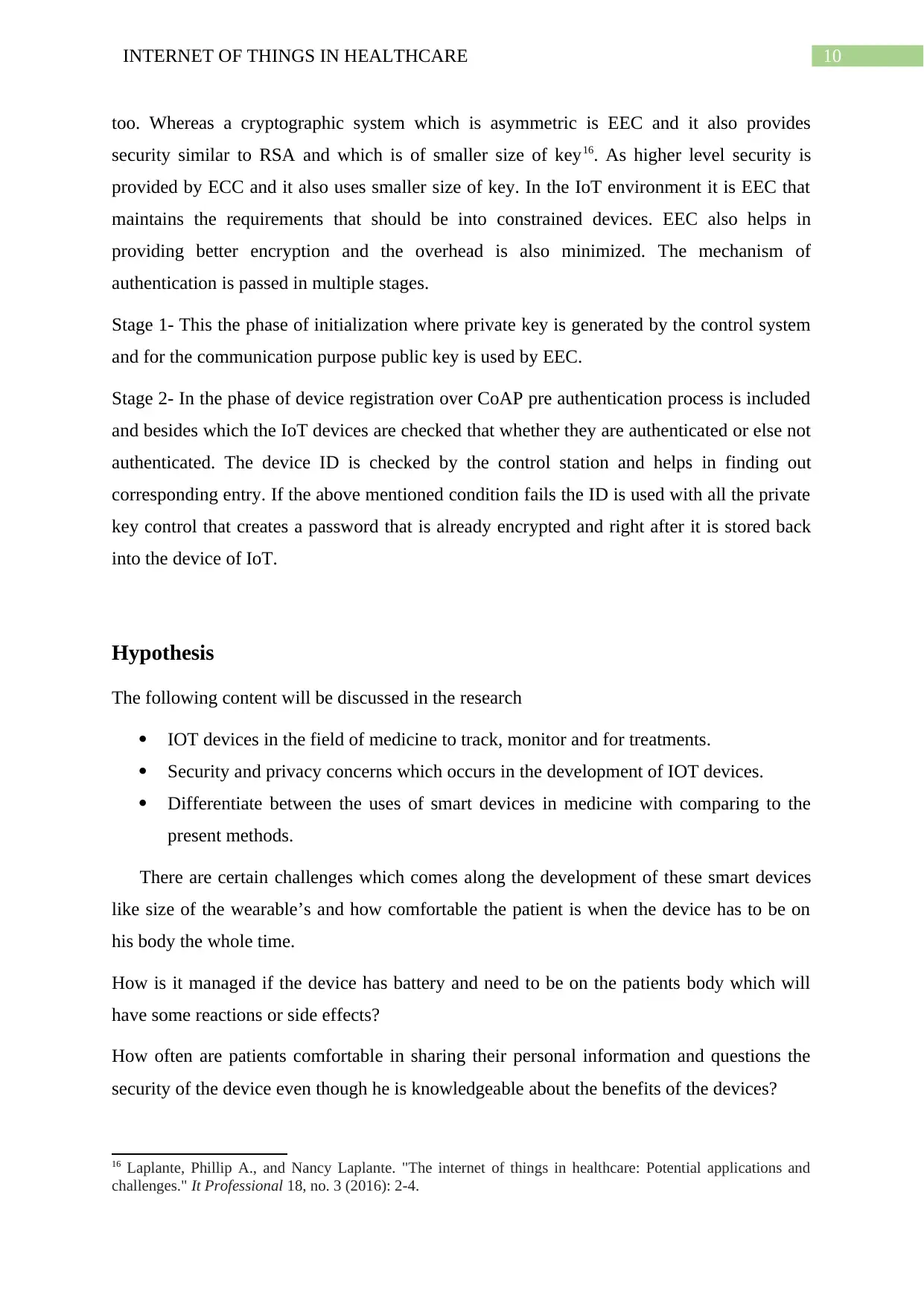
10INTERNET OF THINGS IN HEALTHCARE
too. Whereas a cryptographic system which is asymmetric is EEC and it also provides
security similar to RSA and which is of smaller size of key16. As higher level security is
provided by ECC and it also uses smaller size of key. In the IoT environment it is EEC that
maintains the requirements that should be into constrained devices. EEC also helps in
providing better encryption and the overhead is also minimized. The mechanism of
authentication is passed in multiple stages.
Stage 1- This the phase of initialization where private key is generated by the control system
and for the communication purpose public key is used by EEC.
Stage 2- In the phase of device registration over CoAP pre authentication process is included
and besides which the IoT devices are checked that whether they are authenticated or else not
authenticated. The device ID is checked by the control station and helps in finding out
corresponding entry. If the above mentioned condition fails the ID is used with all the private
key control that creates a password that is already encrypted and right after it is stored back
into the device of IoT.
Hypothesis
The following content will be discussed in the research
IOT devices in the field of medicine to track, monitor and for treatments.
Security and privacy concerns which occurs in the development of IOT devices.
Differentiate between the uses of smart devices in medicine with comparing to the
present methods.
There are certain challenges which comes along the development of these smart devices
like size of the wearable’s and how comfortable the patient is when the device has to be on
his body the whole time.
How is it managed if the device has battery and need to be on the patients body which will
have some reactions or side effects?
How often are patients comfortable in sharing their personal information and questions the
security of the device even though he is knowledgeable about the benefits of the devices?
16 Laplante, Phillip A., and Nancy Laplante. "The internet of things in healthcare: Potential applications and
challenges." It Professional 18, no. 3 (2016): 2-4.
too. Whereas a cryptographic system which is asymmetric is EEC and it also provides
security similar to RSA and which is of smaller size of key16. As higher level security is
provided by ECC and it also uses smaller size of key. In the IoT environment it is EEC that
maintains the requirements that should be into constrained devices. EEC also helps in
providing better encryption and the overhead is also minimized. The mechanism of
authentication is passed in multiple stages.
Stage 1- This the phase of initialization where private key is generated by the control system
and for the communication purpose public key is used by EEC.
Stage 2- In the phase of device registration over CoAP pre authentication process is included
and besides which the IoT devices are checked that whether they are authenticated or else not
authenticated. The device ID is checked by the control station and helps in finding out
corresponding entry. If the above mentioned condition fails the ID is used with all the private
key control that creates a password that is already encrypted and right after it is stored back
into the device of IoT.
Hypothesis
The following content will be discussed in the research
IOT devices in the field of medicine to track, monitor and for treatments.
Security and privacy concerns which occurs in the development of IOT devices.
Differentiate between the uses of smart devices in medicine with comparing to the
present methods.
There are certain challenges which comes along the development of these smart devices
like size of the wearable’s and how comfortable the patient is when the device has to be on
his body the whole time.
How is it managed if the device has battery and need to be on the patients body which will
have some reactions or side effects?
How often are patients comfortable in sharing their personal information and questions the
security of the device even though he is knowledgeable about the benefits of the devices?
16 Laplante, Phillip A., and Nancy Laplante. "The internet of things in healthcare: Potential applications and
challenges." It Professional 18, no. 3 (2016): 2-4.
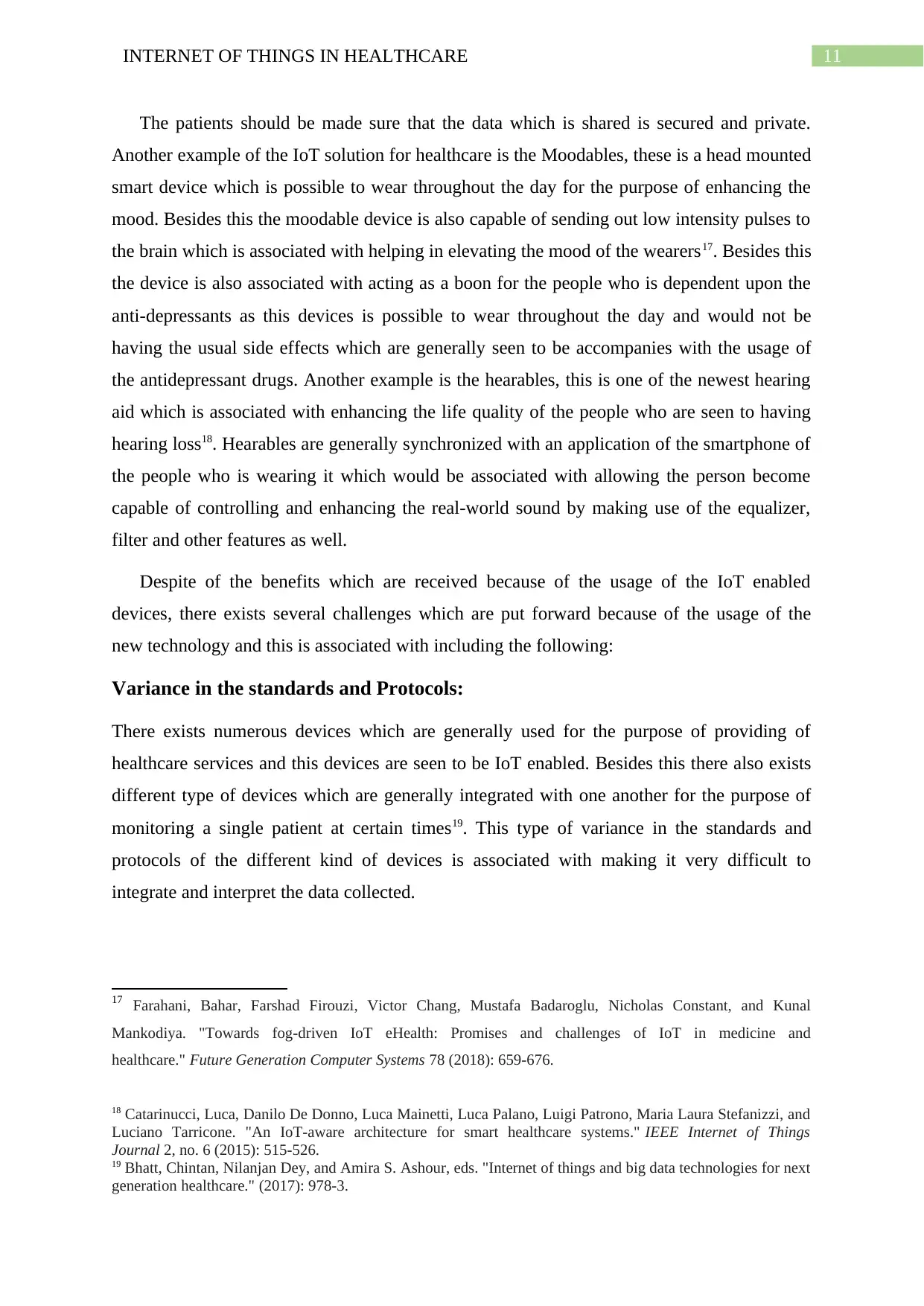
11INTERNET OF THINGS IN HEALTHCARE
The patients should be made sure that the data which is shared is secured and private.
Another example of the IoT solution for healthcare is the Moodables, these is a head mounted
smart device which is possible to wear throughout the day for the purpose of enhancing the
mood. Besides this the moodable device is also capable of sending out low intensity pulses to
the brain which is associated with helping in elevating the mood of the wearers17. Besides this
the device is also associated with acting as a boon for the people who is dependent upon the
anti-depressants as this devices is possible to wear throughout the day and would not be
having the usual side effects which are generally seen to be accompanies with the usage of
the antidepressant drugs. Another example is the hearables, this is one of the newest hearing
aid which is associated with enhancing the life quality of the people who are seen to having
hearing loss18. Hearables are generally synchronized with an application of the smartphone of
the people who is wearing it which would be associated with allowing the person become
capable of controlling and enhancing the real-world sound by making use of the equalizer,
filter and other features as well.
Despite of the benefits which are received because of the usage of the IoT enabled
devices, there exists several challenges which are put forward because of the usage of the
new technology and this is associated with including the following:
Variance in the standards and Protocols:
There exists numerous devices which are generally used for the purpose of providing of
healthcare services and this devices are seen to be IoT enabled. Besides this there also exists
different type of devices which are generally integrated with one another for the purpose of
monitoring a single patient at certain times19. This type of variance in the standards and
protocols of the different kind of devices is associated with making it very difficult to
integrate and interpret the data collected.
17 Farahani, Bahar, Farshad Firouzi, Victor Chang, Mustafa Badaroglu, Nicholas Constant, and Kunal
Mankodiya. "Towards fog-driven IoT eHealth: Promises and challenges of IoT in medicine and
healthcare." Future Generation Computer Systems 78 (2018): 659-676.
18 Catarinucci, Luca, Danilo De Donno, Luca Mainetti, Luca Palano, Luigi Patrono, Maria Laura Stefanizzi, and
Luciano Tarricone. "An IoT-aware architecture for smart healthcare systems." IEEE Internet of Things
Journal 2, no. 6 (2015): 515-526.
19 Bhatt, Chintan, Nilanjan Dey, and Amira S. Ashour, eds. "Internet of things and big data technologies for next
generation healthcare." (2017): 978-3.
The patients should be made sure that the data which is shared is secured and private.
Another example of the IoT solution for healthcare is the Moodables, these is a head mounted
smart device which is possible to wear throughout the day for the purpose of enhancing the
mood. Besides this the moodable device is also capable of sending out low intensity pulses to
the brain which is associated with helping in elevating the mood of the wearers17. Besides this
the device is also associated with acting as a boon for the people who is dependent upon the
anti-depressants as this devices is possible to wear throughout the day and would not be
having the usual side effects which are generally seen to be accompanies with the usage of
the antidepressant drugs. Another example is the hearables, this is one of the newest hearing
aid which is associated with enhancing the life quality of the people who are seen to having
hearing loss18. Hearables are generally synchronized with an application of the smartphone of
the people who is wearing it which would be associated with allowing the person become
capable of controlling and enhancing the real-world sound by making use of the equalizer,
filter and other features as well.
Despite of the benefits which are received because of the usage of the IoT enabled
devices, there exists several challenges which are put forward because of the usage of the
new technology and this is associated with including the following:
Variance in the standards and Protocols:
There exists numerous devices which are generally used for the purpose of providing of
healthcare services and this devices are seen to be IoT enabled. Besides this there also exists
different type of devices which are generally integrated with one another for the purpose of
monitoring a single patient at certain times19. This type of variance in the standards and
protocols of the different kind of devices is associated with making it very difficult to
integrate and interpret the data collected.
17 Farahani, Bahar, Farshad Firouzi, Victor Chang, Mustafa Badaroglu, Nicholas Constant, and Kunal
Mankodiya. "Towards fog-driven IoT eHealth: Promises and challenges of IoT in medicine and
healthcare." Future Generation Computer Systems 78 (2018): 659-676.
18 Catarinucci, Luca, Danilo De Donno, Luca Mainetti, Luca Palano, Luigi Patrono, Maria Laura Stefanizzi, and
Luciano Tarricone. "An IoT-aware architecture for smart healthcare systems." IEEE Internet of Things
Journal 2, no. 6 (2015): 515-526.
19 Bhatt, Chintan, Nilanjan Dey, and Amira S. Ashour, eds. "Internet of things and big data technologies for next
generation healthcare." (2017): 978-3.
⊘ This is a preview!⊘
Do you want full access?
Subscribe today to unlock all pages.

Trusted by 1+ million students worldwide
1 out of 28
Related Documents
Your All-in-One AI-Powered Toolkit for Academic Success.
+13062052269
info@desklib.com
Available 24*7 on WhatsApp / Email
![[object Object]](/_next/static/media/star-bottom.7253800d.svg)
Unlock your academic potential
Copyright © 2020–2025 A2Z Services. All Rights Reserved. Developed and managed by ZUCOL.




